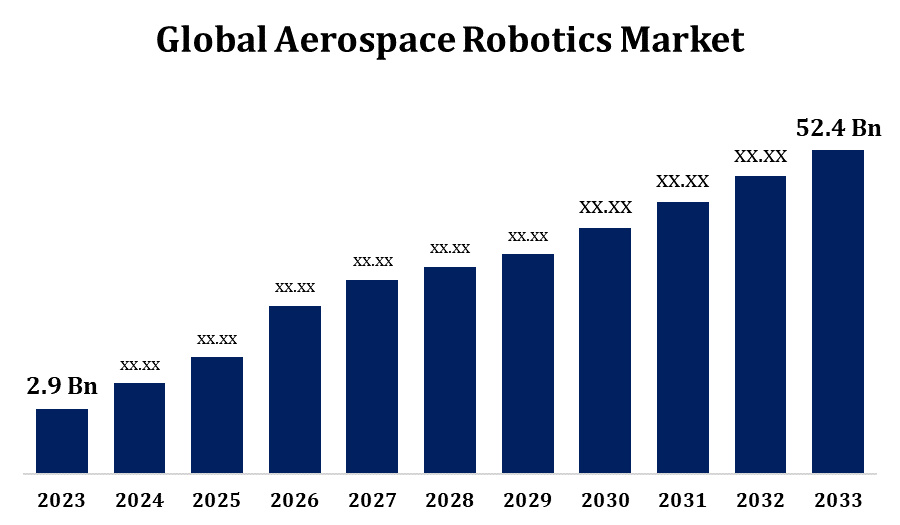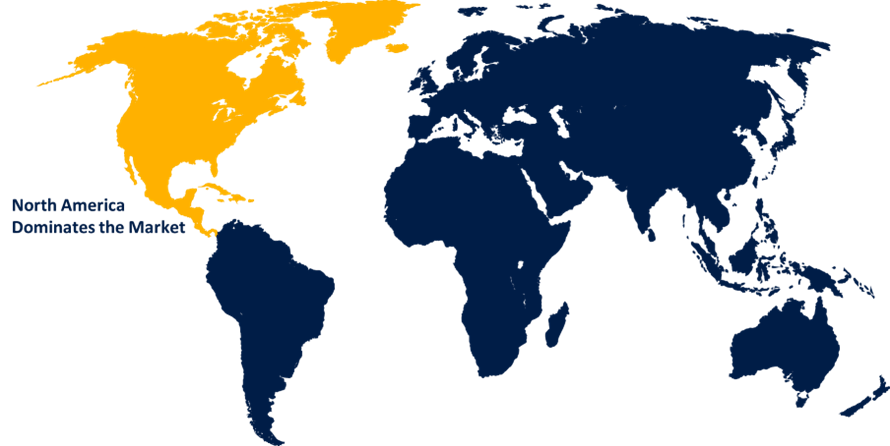Global Aerospace Robotics Market Size, Share, and COVID-19 Impact Analysis, By Application (Material Handling, Surface Treatment, Composites Applications, Assembly, and Others), By Technology (Conventional, Collaborative), By Solution (Hardware, Software, and Services), and By Region (North America, Europe, Asia-Pacific, Latin America, Middle East, and Africa), Analysis and Forecast 2023 - 2033.
Industry: Aerospace & DefenseGlobal Aerospace Robotics Market Insights Forecasts to 2033
- The Aerospace Robotics Market Size was valued at USD 2.9 Billion in 2023.
- The Market Size is Growing at a CAGR of 37.31% from 2023 to 2033
- The Worldwide Aerospace Robotics Market Size is Expected to reach USD 52.4 Billion by 2033
- Asia Pacific is Bxpected to Grow the fastest during the forecast period

Get more details on this report -
The Global Aerospace Robotics Market is Expected to reach USD 52.4 Billion by 2033, at a CAGR of 37.31% during the forecast period 2023 to 2033.
The aerospace robotics market is witnessing significant Growth driven by advancements in automation technology, rising demand for aircraft production, and stringent safety regulations. These robots are utilized in various applications including drilling, welding, painting, and assembly, enhancing efficiency and precision while reducing production time and costs. Key players in the market are continuously investing in research and development to introduce innovative robotic solutions capable of handling complex tasks with high accuracy. Additionally, the adoption of robotics in maintenance, repair, and overhaul (MRO) activities is further propelling market growth.
Aerospace Robotics Market Value Chain Analysis
The aerospace robotics market value chain encompasses various stages, starting from raw material procurement to the final delivery of robotic systems and services. At the initial stage, suppliers provide materials such as metals, electronics, and software components. Manufacturers then design, assemble, and integrate these components to develop robotic systems tailored to aerospace applications. Distributors play a crucial role in marketing and selling these systems to end-users, including aircraft manufacturers, maintenance facilities, and research institutions. Service providers offer installation, training, maintenance, and technical support to ensure optimal performance throughout the lifecycle of the robotics. Additionally, stakeholders like regulatory bodies and industry associations contribute by establishing standards and promoting technological advancements. This comprehensive value chain ensures the seamless development, distribution, and utilization of aerospace robotics, driving efficiency and innovation in the aerospace sector.
Aerospace Robotics Market Opportunity Analysis
The aerospace robotics market presents a multitude of opportunities fueled by several factors. Firstly, the increasing demand for aircraft across commercial, military, and space sectors is driving the need for advanced automation solutions to enhance production efficiency and meet stringent quality standards. Additionally, the rising focus on reducing operational costs and improving safety in aerospace manufacturing processes creates a conducive environment for the adoption of robotics. Moreover, the emergence of new technologies such as artificial intelligence, machine learning, and collaborative robotics further expands the capabilities and applications of aerospace robotics. Furthermore, the growing trend towards automation in maintenance, repair, and overhaul (MRO) operations offers another avenue for market growth. Overall, the aerospace robotics market is poised for significant expansion, driven by the ever-evolving needs of the aerospace industry and the continuous innovation in robotic technologies.
Global Aerospace Robotics Market Report Coverage
| Report Coverage | Details |
|---|---|
| Base Year: | 2023 |
| Market Size in 2023: | USD 2.9 Billion |
| Forecast Period: | 2023-2033 |
| Forecast Period CAGR 2023-2033 : | 37.31% |
| 2033 Value Projection: | USD 52.4 Billion |
| Historical Data for: | 2019-2022 |
| No. of Pages: | 239 |
| Tables, Charts & Figures: | 110 |
| Segments covered: | By Application, By Technology, By Solution, By Region |
| Companies covered:: | Kuka AG, ABB Group, Fanuc Corporation, Yaskawa Electric, Kawasaki Heavy Industries, MtorresKuka AG, ABB Group, Fanuc Corporation, Yaskawa Electric, Kawasaki Heavy Industries, Mtorres, Oliver Crispin Robotics, Gudel Ag, Electroimpact Inc., Universal Robots A/S, Swisslog Ag, Reis Robotics, Boston Dynamics, Bosch Rexroth, Oliver Crispin Robotics, Gudel Ag, Electroimpact Inc., Universal Robots A/S, Swisslog Ag, Reis Robotics, Boston Dynamics, Bosch Rexroth, and Others |
| Pitfalls & Challenges: | Covid-19 Empact, Challenges, Growth, Analysis. |
Get more details on this report -
Market Dynamics
Aerospace Robotics Market Dynamics
Increasing Investment in Aerospace Robotics to Drive Growth.
These investments are driven by several factors, including the escalating demand for automation solutions in aerospace manufacturing and maintenance processes. With a focus on enhancing efficiency, precision, and safety, aerospace companies are allocating substantial funds to adopt advanced robotic technologies. Moreover, the integration of robotics enables manufacturers to meet the increasing demand for aircraft while maintaining stringent quality standards. Additionally, advancements in robotics, such as AI and collaborative robots, are attracting further investment by offering enhanced capabilities and versatility in aerospace applications. Furthermore, the growing emphasis on sustainability and reducing carbon footprints in aerospace manufacturing is driving investment in robotics to optimize resource utilization and minimize waste.
Restraints & Challenges
The aerospace robotics market confronts several challenges hindering its widespread adoption. Chief among these is the significant upfront investment required for implementing robotic solutions in aerospace manufacturing and maintenance operations. Customization costs and integration complexities amplify this challenge, restricting access for some companies. Additionally, cybersecurity vulnerabilities within robotic systems raise concerns regarding data protection and infrastructure security, further complicating adoption efforts. Stringent regulatory standards in the aerospace sector impose rigorous safety and quality requirements, necessitating meticulous compliance measures. Furthermore, the shortage of skilled personnel proficient in robotics and automation technologies presents an obstacle to realizing the full potential of aerospace robotics.
Regional Forecasts
North America Market Statistics

Get more details on this report -
North America is anticipated to dominate the Aerospace Robotics Market from 2023 to 2033. The region boasts a robust aerospace industry with major players like Boeing and Lockheed Martin, driving demand for advanced automation solutions to enhance manufacturing efficiency and maintain competitiveness. Additionally, increasing investments in research and development, particularly in emerging technologies such as artificial intelligence and collaborative robotics, are fueling innovation in aerospace robotics. Furthermore, the presence of a well-established network of suppliers and service providers specializing in robotics further supports market growth.
Asia Pacific Market Statistics
Asia Pacific is witnessing the fastest market growth between 2023 to 2033. The expanding aerospace industry in countries like China, Japan, and India, coupled with increasing investments in automation and robotics, is fueling demand for advanced robotic solutions. Rising aircraft production rates, driven by growing air travel demand and defense modernization initiatives, are further boosting market expansion. Moreover, government initiatives aimed at promoting technological innovation and industrial automation are providing impetus to the aerospace robotics market in the region. However, challenges such as the need for skilled labor and concerns regarding intellectual property protection persist. Despite these challenges, the Asia Pacific aerospace robotics market is poised for substantial growth, leveraging its burgeoning aerospace sector and increasing focus on automation to drive innovation and competitiveness in the global market.
Segmentation Analysis
Insights by Application
The composites segment accounted for the largest market share over the forecast period 2023 to 2033. Composites offer significant advantages in aerospace applications due to their lightweight, high strength-to-weight ratio, and corrosion resistance properties. Aerospace manufacturers increasingly rely on composite materials to reduce aircraft weight, improve fuel efficiency, and enhance overall performance. Robotics play a crucial role in the fabrication, assembly, and inspection of composite components, ensuring precision and efficiency in manufacturing processes. Moreover, advancements in robotic technologies, such as automated fiber placement and robotic composite layup, enable complex composite structures to be produced with high accuracy and repeatability.
Insights by Technology
The collaborative technology segment is dominating the market with the largest market share over the forecast period 2023 to 2033. Collaborative robots, or cobots, are increasingly deployed in aerospace manufacturing tasks due to their ability to work alongside human operators without the need for safety barriers. This close collaboration enhances efficiency and safety while optimizing production workflows. Cobots excel in tasks such as assembly, inspection, and material handling, particularly in environments where precision and flexibility are paramount. Additionally, advancements in sensor technology and artificial intelligence empower these robots to adapt to dynamic manufacturing environments and perform complex tasks with ease. As aerospace manufacturers prioritize productivity and address labor shortages, the adoption of collaborative technology continues to surge, driving significant growth within the aerospace robotics market.
Insights by Solution
The hardware segment is dominating the market with the largest market share over the forecast period 2023 to 2033. Aerospace robotics hardware encompasses a wide range of components and systems including robotic arms, end-effectors, sensors, controllers, and peripherals. As the aerospace industry increasingly adopts automation and robotics to streamline manufacturing processes, there is a growing demand for advanced hardware solutions tailored to aerospace applications. Manufacturers are investing in research and development to enhance the performance, durability, and reliability of robotics hardware, ensuring optimal functionality in challenging aerospace environments. Moreover, advancements in materials, sensor technologies, and control systems are driving innovation in aerospace robotics hardware, enabling more precise, efficient, and versatile operations.
Recent Market Developments
- In July 2021, Fanuc Corporation stated that it has begun manufacture of its 750,000th industrial robot, a record high in the robotics sector.
Competitive Landscape
Major players in the market
- Kuka AG
- ABB Group
- Fanuc Corporation
- Yaskawa Electric
- Kawasaki Heavy Industries
- Mtorres
- Oliver Crispin Robotics
- Gudel Ag
- Electroimpact Inc.
- Universal Robots A/S
- Swisslog Ag
- Reis Robotics
- Boston Dynamics
- Bosch Rexroth
Market Segmentation
This study forecasts revenue at global, regional, and country levels from 2023 to 2033.
Aerospace Robotics Market, Application Analysis
- Material Handling
- Surface Treatment
- Composites Applications
- Assembly
- Others
Aerospace Robotics Market, Technology Analysis
- Conventional
- Collaborative
Aerospace Robotics Market, Solution Analysis
- Hardware
- Software
- Services
Aerospace Robotics Market, Regional Analysis
- North America
- US
- Canada
- Mexico
- Europe
- Germany
- Uk
- France
- Italy
- Spain
- Russia
- Rest of Europe
- Asia Pacific
- China
- Japan
- India
- South Korea
- Australia
- Rest of Asia Pacific
- South America
- Brazil
- Argentina
- Rest of South America
- Middle East & Africa
- UAE
- Saudi Arabia
- Qatar
- South Africa
- Rest of the Middle East & Africa
Frequently Asked Questions (FAQ)
-
1. What is the Market size of the Aerospace Robotics Market?The Global Aerospace Robotics Market is Expected to Grow from USD 2.9 billion in 2023 to USD 52.4 billion by 2033, at a CAGR of 37.31% during the forecast period 2023-2033.
-
2. Who are the key market players of the Aerospace Robotics Market?Some of the key market players of the market are Kuka AG, ABB Group, Fanuc Corporation, Yaskawa Electric, Kawasaki Heavy Industries, Mtorres, Oliver Crispin Robotics, Gudel Ag, Electroimpact Inc., Universal Robots A/S, Swisslog Ag, Reis Robotics, Boston Dynamics, Bosch Rexroth.
-
3. Which segment holds the largest market share?The hardware segment holds the largest market share and is going to continue its dominance.
-
4. Which region dominates the Aerospace Robotics market?North America dominates the Aerospace Robotics market and has the highest market share.
Need help to buy this report?